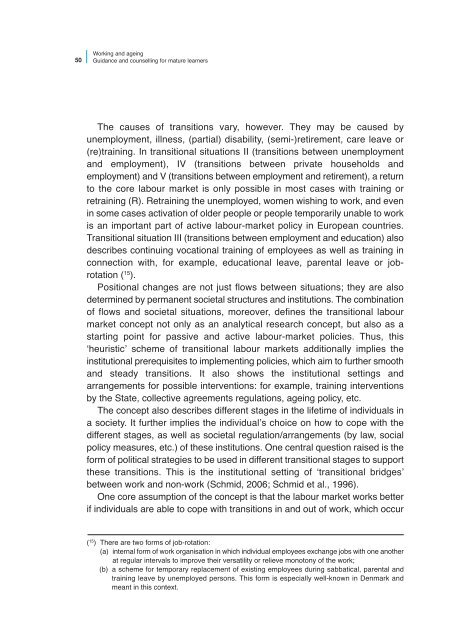Working and ageing - Cedefop - Europa
Working and ageing - Cedefop - Europa
Working and ageing - Cedefop - Europa
Create successful ePaper yourself
Turn your PDF publications into a flip-book with our unique Google optimized e-Paper software.
50<br />
<strong>Working</strong> <strong>and</strong> <strong>ageing</strong><br />
Guidance <strong>and</strong> counselling for mature learners<br />
The causes of transitions vary, however. They may be caused by<br />
unemployment, illness, (partial) disability, (semi-)retirement, care leave or<br />
(re)training. In transitional situations II (transitions between unemployment<br />
<strong>and</strong> employment), IV (transitions between private households <strong>and</strong><br />
employment) <strong>and</strong> V (transitions between employment <strong>and</strong> retirement), a return<br />
to the core labour market is only possible in most cases with training or<br />
retraining (R). Retraining the unemployed, women wishing to work, <strong>and</strong> even<br />
in some cases activation of older people or people temporarily unable to work<br />
is an important part of active labour-market policy in European countries.<br />
Transitional situation III (transitions between employment <strong>and</strong> education) also<br />
describes continuing vocational training of employees as well as training in<br />
connection with, for example, educational leave, parental leave or jobrotation<br />
( 15 ).<br />
Positional changes are not just flows between situations; they are also<br />
determined by permanent societal structures <strong>and</strong> institutions. The combination<br />
of flows <strong>and</strong> societal situations, moreover, defines the transitional labour<br />
market concept not only as an analytical research concept, but also as a<br />
starting point for passive <strong>and</strong> active labour-market policies. Thus, this<br />
ʻheuristicʼ scheme of transitional labour markets additionally implies the<br />
institutional prerequisites to implementing policies, which aim to further smooth<br />
<strong>and</strong> steady transitions. It also shows the institutional settings <strong>and</strong><br />
arrangements for possible interventions: for example, training interventions<br />
by the State, collective agreements regulations, <strong>ageing</strong> policy, etc.<br />
The concept also describes different stages in the lifetime of individuals in<br />
a society. It further implies the individualʼs choice on how to cope with the<br />
different stages, as well as societal regulation/arrangements (by law, social<br />
policy measures, etc.) of these institutions. One central question raised is the<br />
form of political strategies to be used in different transitional stages to support<br />
these transitions. This is the institutional setting of ʻtransitional bridgesʼ<br />
between work <strong>and</strong> non-work (Schmid, 2006; Schmid et al., 1996).<br />
One core assumption of the concept is that the labour market works better<br />
if individuals are able to cope with transitions in <strong>and</strong> out of work, which occur<br />
( 15 ) There are two forms of job-rotation:<br />
(a) internal form of work organisation in which individual employees exchange jobs with one another<br />
at regular intervals to improve their versatility or relieve monotony of the work;<br />
(b) a scheme for temporary replacement of existing employees during sabbatical, parental <strong>and</strong><br />
training leave by unemployed persons. This form is especially well-known in Denmark <strong>and</strong><br />
meant in this context.

















